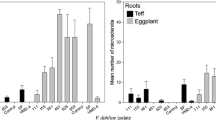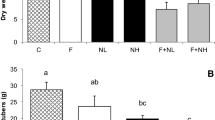Abstract
Relative disease severity (seedpiece decay or post emergence blackleg) incited byErwinia carotovora var.carotovora (Ecc) andErwinia carotovora var.atroseptica (Eca) was studied in the field and the greenhouse. When inoculated tubers were planted in cool soils in the field or greenhouse (7.0–18.5°C average minimum and 16–26°C average maximum temperature during the first 30 days after planting)Eca caused significantly more disease thanEcc. Under these experimental conditionsEcc did not cause significantly more disease than that found in non-inoculated controls. When soil temperatures were high at planting time (21.4–24.0°C average minimum and 29.6–35.0°C average maximum temperature for the first 30 days after planting), inoculation withEcc resulted in severe disease whileEca produced no more infection than that found in uninoculated controls. At intermediate soil temperatures both were infective.
Seedpiece decay by both organisms was correlated with soil temperatures during the first 30 days after planting. As the soil temperature increased, inoculation withEcc resulted in more disease than inoculation withEca. At lower soil temperatures the opposite result was obtained.
Field and greenhouse studies showed that bothEca andEcc were able to cause typical post emergence blackleg infection, the former at low soil temperature and the latter at high temperature conditions.
The data suggest that bothEcc andEca are components of the potato blackleg and soft rot disease complex. Environmental conditions, especially soil temperature, determine which organism is causative under a particular set of conditions.
Resumen
Severidad relativa de la enfermedad (pudrición de semilla de papa o pierna negra de post-emergencia) causada porErwinia carotovora var.carotovora (Ecc) yErwinia carotovora var.atroseptica (Eca) fue estudiada en el campo y en invernadero. Cuando tubérculos inoculados fueron sembrados en suelos frios del campo o invernadero (7–18.5° C promedio mínimo y 16–26° C promedio máximo de temperatura durante los primeros 30 dias después de la siembra) Eca causó significativamente más daño que Ecc. Bajo estas condiciones experimentales Ecc no causó significativamente más enfermedad que la que se encontró en los controles no inoculados. Cuando las temperaturas del suelo fueron altas en la siembra (21.4–24.0° C de promedio mínimo y 29.6–35.0° C de promedio máximo durante los primeros 30 dias después de la siembra) la inoculación con Ecc produjó una severa enfermedad mientras Eca no produjó major infección que la encontrada en controles no inoculados. A temperaturas intermedias del suelo ambas fueron infectivas.
La pudrición de semilla de papa causada por los dos organismos estuvo correlacionada con las temperaturas del suelo durante los primeros 30 días después de la siembra. A medida que la temperatura del suelo aumenta, la inoculación con Ecc produce mayor enfermedad que la inoculación con Eca. A temperaturas bajas del suelo el resultado opuesto fue obtenido.
Estudios de campo e invernadero mostraron que tanto Eca como Ecc podían causar una típica pierna negra de post-emergencia, la primera a temperaturas bajas del suelo y la última a temperaturas altas.
La información sugiere que Ecc y Eca son componentes del complejo pierna negra de la papa y pudrición de planta. Las condiciones ambientales, especialmente la temperatura del suelo, determinan cual organismo es el causante bajo un conjunto particular de condiciones.
Similar content being viewed by others
Literature Cited
Aleck, J.R. 1973. The development of potato blackleg in relation to inoculum density and environment. M.S. Thesis, Dept. of Botany and Plant Pathology, Colorado State University, 90 p.
Bliss, C.I. 1937. Analysis of field experimental data expressed in percentages. Plant Protection 12:67–77 (Institute of Plant Protection, Leningrad, U.S.S.R.).
Burkholder, W.H., and W.L. Smith. 1949.Erwinia atroseptica (van Hall) Jennison andErwinia carotovora (Jones) Holland. Phytopathology 39:887–897.
Graham, D.C., and J.L. Hardie. 1971. Prospects for control of potato blackleg disease by the use of stem cuttings. Proc 6th Brit Insectic Fungic Conf pp. 219–224.
Harrison, M.D., C.H. Livingston, and N. Oshima. 1965. An improved system for controlling soil temperature in the study of soilborne plant pathogens. Plant Dis Rept 49:452–454.
Harrison, M.D., C.E. Quinn, I. Ann Sells, and D.C. Graham. 1977. Waste potato dumps as sources of insects contaminated with soft rot coliform bacteria in relation to recontamination of pathogen-free potato stocks. Potato Res 20:37–52.
Hingorani, M.K., and S.K. Addy. 1952. A comparative study ofErwinia carotovora, Erwinia aroideae andErwinia atroseptica. Indian Phytopathol 5:40–43.
Kloepper, J.W., and M.D. Harrison. 1976. Insect contamination withErwinia carotovora var.carotovora and var.atroseptica in nature in the San Luis Valley. Proc 89th Annu Res Conf Colorado State University, 95 p.
Lazar, I., and E. Bucur. 1964. Recent research in Roumania on blackleg and bacterial soft rot of potato. Eur Potato J 7:102–111.
Lelliott, R.A. 1974. Description of the species of genusErwinia. Pages 332–340in R.E. Buchanan and N.E. Gibbons, eds. Bergey’s Manual of Determinative Bacteriology. 8th ed. Williams and Wilkins, Baltimore, Maryland. 1246 p.
Logan, C. 1968. The survival of the potato blackleg pathogen overwinter. Rec Agric Res Minist Agric North Irel 17:115–121.
Meneley, J.C., and M.E. Stanghellini. 1976. Isolation of soft rotErwinia spp. from agricultural soils using an enrichment technique. Phytopathology 66:367–370.
Miles, A.A., and S.S. Misra. 1938. The estimation of the bactericidal power of the blood. J Hyg 38:732.
Molina, J. J., and M.D. Harrison. 1977. The role ofErwinia carotovora in potato blackleg. I. Relationship ofE. carotovora var.carotovora andE. carotovora var.atroseptica to potato blackleg in Colorado. Am Potato J 54:587–591.
Noble, Mary, and M. Marshall. 1952. A note on blackleg of potato. Plant Path 1:134.
Perombelon, M.C.M. 1972. The extent and survival of contamination of potato stocks in Scotland byErwinia carotovora var.carotovora andE. carotovora var.atroseptica. Ann Appl Biol 71:111–117.
Smith, W.L., Jr. 1949. Some specific characters ofErwinia atroseptica andE. carotovora. Phytopathology 39:22–23. (Abstr.)
Smith, M.A., and G.B. Ramsey. 1947. Bacterial lenticel infection of early potatoes. Phytopathology 37:225–242.
Snedecor, G.W., and W.G. Cochran. 1973. Statistical methods. Sixth Edition. Iowa State University Press.
Stanghellini, M.E., and J.C. Meneley. 1975. Identification of soft-rotErwinia associated with blackleg in Arizona. Phytopathology 65:86–87.
Tanii, A., and J. Abai. 1975. Blackleg of potato plant caused by a serologically specific strain ofErwinia carotovora var.carotovora (Jones) Dye. Ann Phytopathol Soc Japan 41:513–517.
Author information
Authors and Affiliations
Additional information
Formerly Graduate Research Assistant.
This work was supported by the Colorado State University Experiment Station as part of the Ph.D. Dissertation of the senior author.
Published as Scientific Series Paper No. 2364.
Rights and permissions
About this article
Cite this article
Molina, J.J., Harrison, M.D. The role ofErwinia carotovora in the epidemiology of potato blackleg. II. The effect of soil temperature on disease severity. American Potato Journal 57, 351–363 (1980). https://doi.org/10.1007/BF02854325
Received:
Issue Date:
DOI: https://doi.org/10.1007/BF02854325




